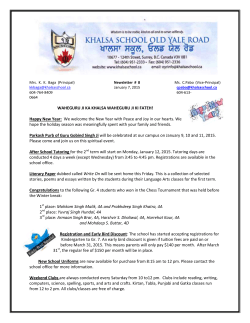
Sabyasachi et al., Flacourtia indica (Burm. f.) Merr
Sabyasachi et al., ISSN 2394 – 692X International Journal of Herbo Medica Vol. - 2 (1) 26 – 27. Jan. – Mar. 2015. Review Article Flacourtia indica (Burm. f.) Merr. – An Ethnopharmacologicaly valuable plant Mousumi Chatterjee1 , Indrani Chandra2 , Sabyasachi Chatterjee3* 1,2,3* - Department of Biotechnology, The University of Burdwan, Golapbag, Burdwan-713104, West Bengal, India *Corresponding author, E-mail:- sabsach@rediffmail.com. Abstract: The scientific study of folk remedies by different ethnic or cultural groups is called as ethnopharmacology. From the ancient age, herbal medicines are in use not only in poverty stricken communities but also in Western society. Rejection of synthetic or biomedical products has become a growing trend in modern culture and a craze is observed for natural medicines. Flacourtia indica (Burm.f.) Merr., commonly known as ‘boichi’ or ‘Indian plum’ is an useful medicinal plant, native to Africa, tropical temperate parts of Asia, India and various part of West Bengal and is becoming threatened day by day. This is a bushy shrub with a spiny trunk and branches belonging to the family Salicaceae. Modern pharmacological studies demonstrated that F.indica possess wide range of active chemical compounds with broad range of medicinal properties viz. antioxidant, hepatoprotective, antiasthmatic, antimalarial etc. The immense medicinal properties of F. indica may open an alternative door to the pharma industry. Key-words- Ethno pharmacology, herbal medicines, Flacourtia indica. Introduction: In some African and Asian countries, upto 80% of the population relies on traditional medicine for the treatment of various diseases. The demand of using traditional or herbal medicine is increasing day by day to avoid the side effects or drug resistancey of synthetic clinical medicines. Traditional or folk medicines are also cheaper and easily available. Flacourtia indica (Burm. f.) merr., synonym of Flacourtia ramontchi (L’Herit) commonly known as ‘boichi’, ‘indian plum’ is a herbal medicinal plant native to Africa and widely distributed in Bangladesh and in various parts of india [1].This is a busy shrub of small tree with strong spiny,erect,branches,growing upto maximum height of 15 mt. The fruit itself is a pome, purplish in colour and sweetish with an acidic tang in taste. Figure 1: Inflorescence Taxonomy: Scientific classification Kingdom: Plantae (Unranked): Angiosperms (Unranked): Eudicots (Unranked): Rosids Order: Malpighiales Family: Salicaceae Genus: Flacourtia Species: F. indica Binominal Name: Flacourtia indica (Burm.f.) Merr Figure 1: Flacourtia indica IJHM - Bioscipress Recent pharmacological activities: According to the history of literatures very few pharmacological activities was established for F.indica .These can be accounted as follows – 26 Sabyasachi et al., Hepatoprotective activity (methotrexate induced hepatotoxicity):- It was reported that the F. indica shows hepatoprotective activity against methotrexate induced hepatotoxicity. This study revealed that the petroleum ether extract of aerial parts, result indicate that the dose of 350 mg/kg orally for 5 days significantly improved level of marker enzymes for liver function and oxidative stress [2]. Hepatoprotective activity (paracetamol induced hepatotoxicity):- It was also investigated that the extraction of F.indica’s aerial part in various solvent like methanol, petroleum ether, ethyl acetate were found to reduce the level of serum glutamic oxaloacetic transaminase(SGOT), serum glutamic pyruvic transaminase(SGPT),and serum alkaline phosphatase (SAP) in paracetamol induced hepatotoxicity. Among those solvent, petroleum ether and ethyl acetate exhibits most significant level of SGOT and SGPT [3]. Hepatoprotective Activity (Carbon tetrachloride induced hepatotoxicity):-It was established that the aqueous extract of F.indica also exhibits the hepatoprotective activity against the oxidative stress caused by the exposure of hepatotoxin carbon tetrachloride [4]. Antioxidant Activity:-Phytochemical analysyis of F.indica showed that the presence of alkaloids, tannins, saponins, flavonoids, glycosides, phenolic compounds, terpenoids and steroids. It was reported that the aqueous and methanolic extract of F.indica exhibits potent free radicals scavenging and antioxidant activity. Hence it was proved that F.indica was an important therapeutic agent in antiaging and oxidative stress related degenerative diseases [5]. Anti asthamatic Activity: It was demonstrated that ethanolic leaf extract possess a prominent anti asthamatic potentiality as these extract contain various pharmacognologically active compound. The anti asthamatic activity of F.indica could be due to its bronchodialatory and cell stabilizing properties. A comparable study of ronchodialating effect of F.indica to ketotifen fumarate was also done invitro condition [6]. Antimalarial activity: It was reported that the aerial parts of F.indica possess strong antimalarial activity. Mainly phytocompound poliothrysoside shows a strong antiplasmodial activity against the chloroquine-resistant strain of Plasmodium falciparum and selectivity index of this compound(>28) is similar to chloroquine [7]. Diuretic activity: It was evaluated that the ethanolic extract of F.indica shows a significant increment in the volume of urine along with the Na+, K+, Cl- ion concentration [8]. IJHM - Bioscipress ISSN 2394 – 692X Conclusion: Flacourtia indica is one of the most useful indigenous medicinal plant in india. Some allied species of F.indica demonstrated various activities like antiinflammatory, antimicrobial, antidiabetic effects explained due to the presence of various compounds viz. flacourtin, sitosterol, ramontoside, sugar, tannin, scoparone etc. Although very less pharmacological activities has been carries out but still it is considered as rich and valuable source of unique phytocompounds which can help to develop medicine against various diseases. So, the quantitative analysis of the various phytoconstituents based on invitro and invivo studies should be further investigated. References: 1. Kirtikar KR and Basu BD; Indian Medicinal Plants, 3rd edition Vol II, Singh and MP Singh Publications, 1998: 220. 2. Varkey J and Thomas J; Protective effect of F.indica (Burm.f) Merr. Methotrexate Induced Hepatotoxicity. In An International Journal of advances in Pharmaceutical sciences, 2011, 2 (2-3):115-123. 3. Nazneen M, Mazid MA, Kundu JK, Bachar SC, Rashid MA and Datta BK. Protective of F.indica aerial parts extracts against paracetamol induced hepatotoxicity in rats. JTUSCI, 2009, vol (2):1-6. 4. Gnanaprakash K.Aqueous extract of F.indica prevents carbon tetrachloride induced hepatotoxicity in rat, International Journal of Biological and Life Sciences, 2010, 6(1):51-55. 5. Tyagi SN, Rakshit, Singh A, Raghvendra, Saxena A and Patel BD; In vitro antioxidant activity of methanolic and aqueous extrct of F.indica. Merr. American- Eurasian Journal of Scientific Research, 2010, 5(3):201-206. 6. Tyagi S, Singh M, Singh D, Yadav I, Singh Sand Mansoori MH; Anti-Asthamatic Potential of F.indica Merr. African Journal of Basic & Applied Sciences, 2011, 3(5):201-204. 7. Kaou AM, Mahiou-Leddet V, Canlet C, Debrauwer L and Hutter S; Antimalarial compounds from the aerial parts of Flacourtia indica (Flacourtiaceae). Journal of Ethnopharmacology, 2010, 130(2): 272-274. 8. Ancy P,Padmaja V,Radha K,Jomy Jose, Hisham A. Diuretic activity of the roots of Flacourtia indica. Hygeia J.D.Med.2013;5(1):79-83. 27
© Copyright 2024













